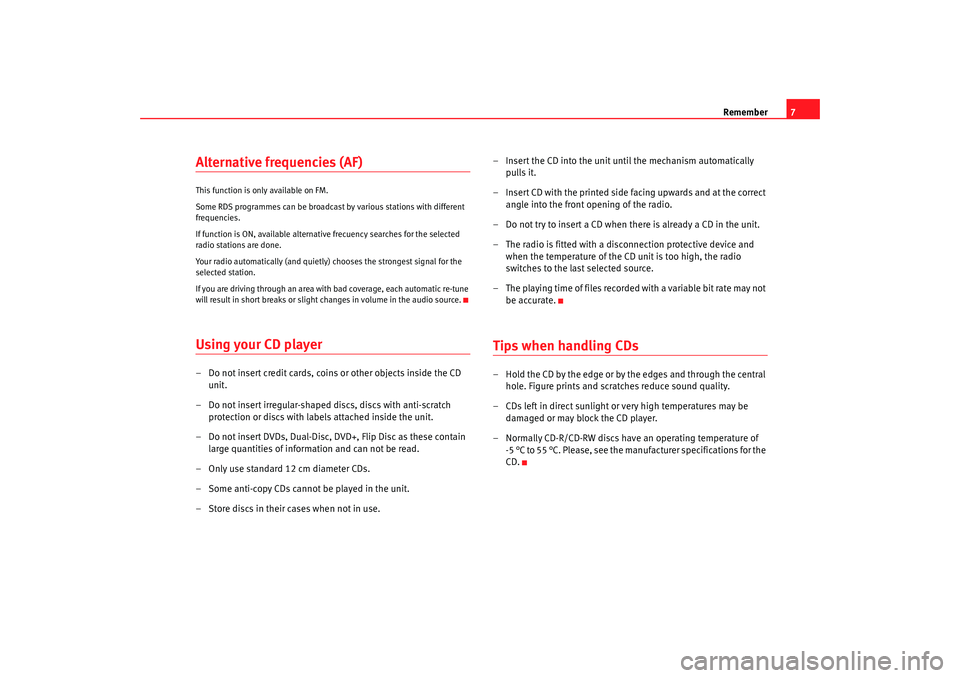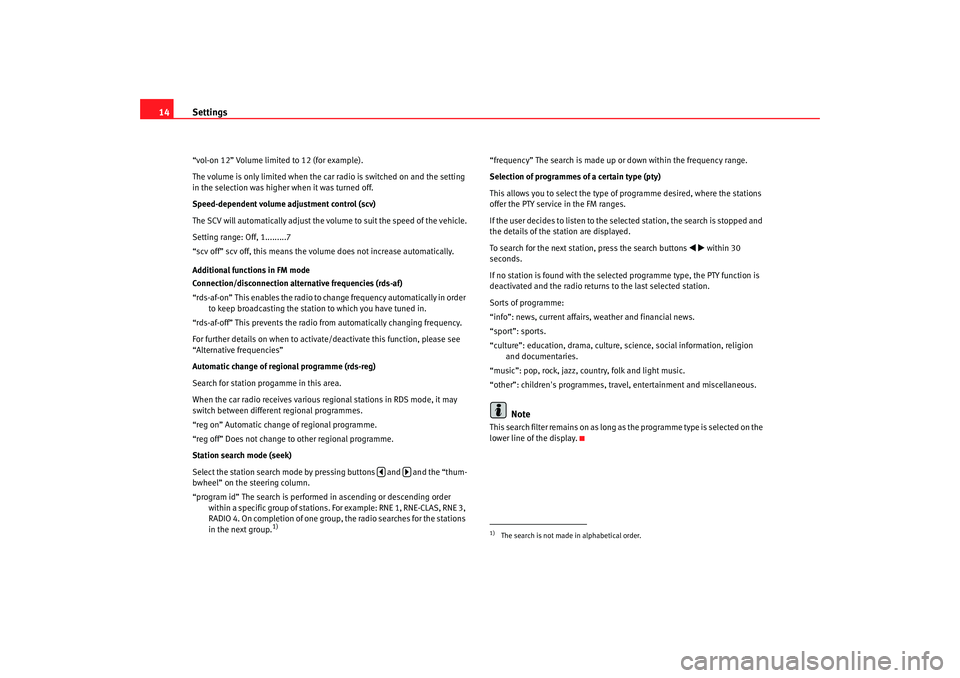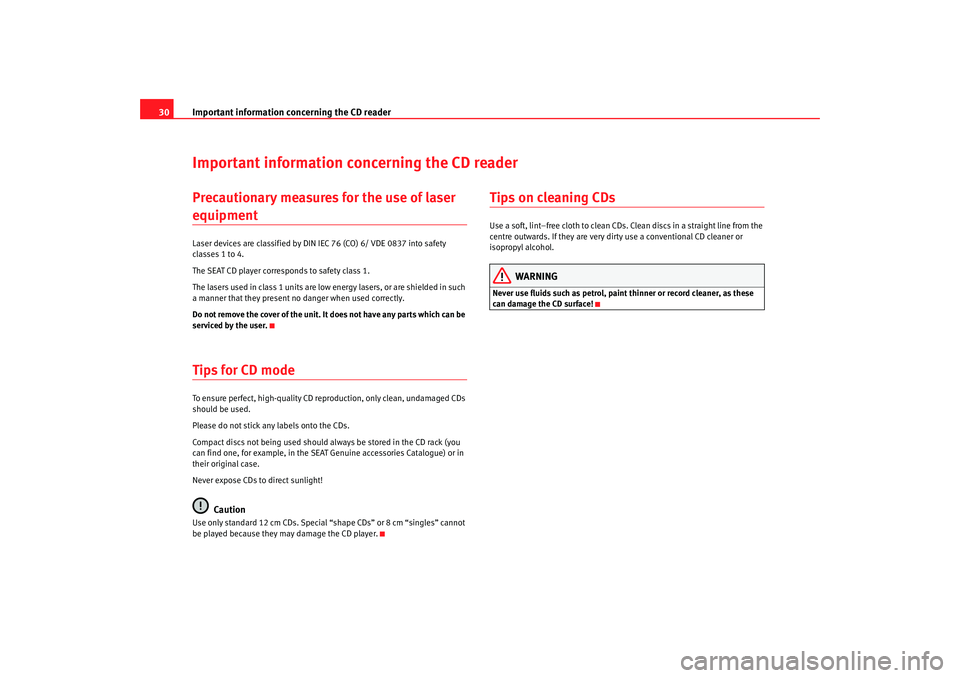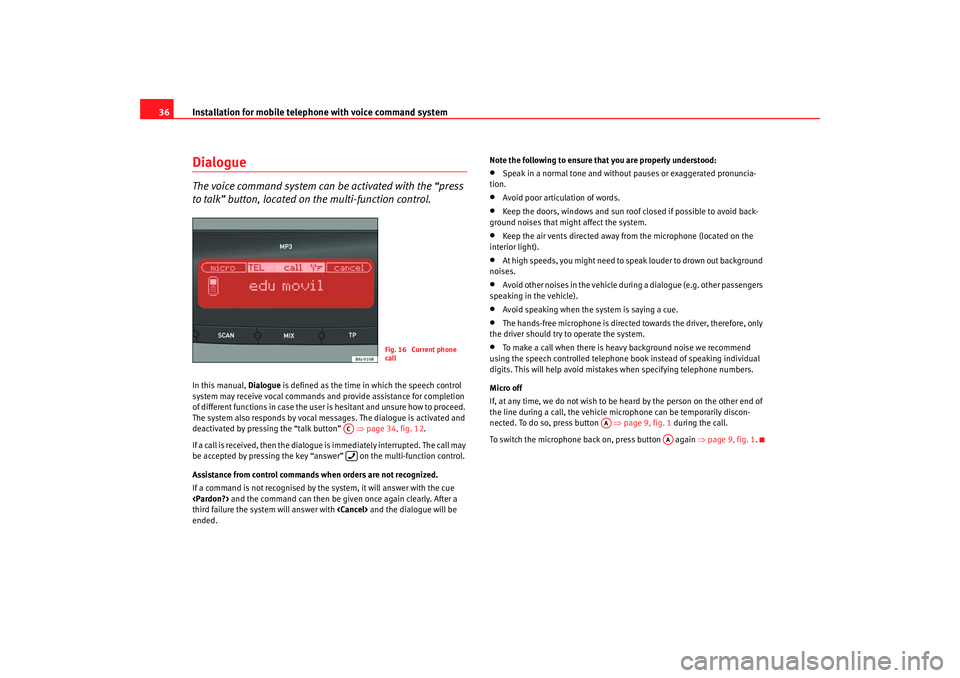2008 Seat Ibiza SC light
[x] Cancel search: lightPage 8 of 54

Remember7
Alternative frequencies (AF) This function is only available on FM.
Some RDS programmes can be broadcast by various stations with different
frequencies.
If function is ON, available alternative frecuency searches for the selected
radio stations are done.
Your radio automatically (and quietly) chooses the strongest signal for the
selected station.
If you are driving through an area with bad coverage, each automatic re-tune
will result in short breaks or slight changes in volume in the audio source.Using your CD player– Do not insert credit cards, coins or other objects inside the CD unit.
– Do not insert irregular-shaped discs, discs with anti-scratch protection or discs with labels attached inside the unit.
– Do not insert DVDs, Dual-Disc, DVD+, Flip Disc as these contain large quantities of information and can not be read.
– Only use standard 12 cm diameter CDs.
– Some anti-copy CDs cannot be played in the unit.
– Store discs in their cases when not in use. – Insert the CD into the unit until the mechanism automatically
pulls it.
– Insert CD with the printed side facing upwards and at the correct angle into the front opening of the radio.
– Do not try to insert a CD when there is already a CD in the unit.
– The radio is fitted with a disconnection protective device and when the temperature of the CD unit is too high, the radio
switches to the last selected source.
– The playing time of files recorded with a variable bit rate may not be accurate.
Tips when handling CDs– Hold the CD by the edge or by the edges and through the central hole. Figure prints and scratches reduce sound quality.
– CDs left in direct sunlight or very high temperatures may be damaged or may block the CD player.
– Normally CD-R/CD-RW discs have an operating temperature of -5 °C to 55 °C. Please, see the manufacturer specifications for the
CD.
Car stereo_EN.book Seite 7 Di enstag, 18. März 2008 4:15 16
Page 15 of 54

Settings
14“vol-on 12” Volume limited to 12 (for example).
The volume is only limited when the car radio is switched on and the setting
in the selection was higher when it was turned off.
Speed-dependent volume adjustment control (scv)
The SCV will automatically adjust the v olume to suit the speed of the vehicle.
Setting range: Off, 1.........7
“scv off” scv off, this means the volume does not increase automatically.
Additional functions in FM mode
Connection/disconnection alternative frequencies (rds-af)
“rds-af-on” This enables the radio to change frequency automatically in order to keep broadcasting the station to which you have tuned in.
“rds-af-off” This prevents the radio from automatically changing frequency.
For further details on when to activate/deactivate this function, please see
“Alternative frequencies”
Automatic change of regional programme (rds-reg)
Search for station progamme in this area.
When the car radio receives various re gional stations in RDS mode, it may
switch between different regional programmes.
“reg on” Automatic change of regional programme.
“reg off” Does not change to other regional programme.
Station search mode (seek)
Select the station search mode by pressing buttons and and the “thum-
bwheel” on the steering column.
“program id” The search is performed in ascending or descending order within a specific group of stations. For example: RNE 1, RNE-CLAS, RNE 3,
RADIO 4. On completion of one group, the radio searches for the stations
in the next group.
1)
“frequency” The search is made up or down within the frequency range.
Selection of programmes of a certain type (pty)
This allows you to select the type of programme desired, where the stations
offer the PTY service in the FM ranges.
If the user decides to listen to the selected station, the search is stopped and
the details of the station are displayed.
To search for the next station, press the search buttons
within 30
seconds.
If no station is found with the selected programme type, the PTY function is
deactivated and the radio returns to the last selected station.
Sorts of programme:
“info”: news, current affairs, weather and financial news.
“sport”: sports.
“culture”: education, drama, culture, science, social information, religion and documentaries.
“music”: pop, rock, jazz, country, folk and light music.
“other”: children's programmes, travel, entertainment and miscellaneous.
Note
This search filter remains on as long as the programme type is selected on the
lower line of the display.
1)The search is not made in alphabetical order.
Car stereo_EN.book Seite 14 Dienstag, 18. März 2008 4:15 16
Page 31 of 54

Important information concerning the CD reader
30Important information concerning the CD readerPrecautionary measures for the use of laser equipmentLaser devices are classified by DIN IEC 76 (CO) 6/ VDE 0837 into safety
classes 1 to 4.
The SEAT CD player corresponds to safety class 1.
The lasers used in class 1 units are low energy lasers, or are shielded in such
a manner that they present no danger when used correctly.
Do not remove the cover of the unit. It does not have any parts which can be
serviced by the user.Tips for CD modeTo ensure perfect, high-quality CD reproduction, only clean, undamaged CDs
should be used.
Please do not stick any labels onto the CDs.
Compact discs not being used should always be stored in the CD rack (you
can find one, for example, in the SEAT Genuine accessories Catalogue) or in
their original case.
Never expose CDs to direct sunlight!
Caution
Use only standard 12 cm CDs. Special “shape CDs” or 8 cm “singles” cannot
be played because they may damage the CD player.
Tips on cleaning CDsUse a soft, lint–free cloth to clean CDs. Clean discs in a straight line from the
centre outwards. If they are very dirty use a conventional CD cleaner or
isopropyl alcohol.
WARNING
Never use fluids such as petrol, paint thinner or record cleaner, as these
can damage the CD surface!
Car stereo_EN.book Seite 30 Dienstag, 18. März 2008 4:15 16
Page 37 of 54

Installation for mobile telephone with voice command system
36Dialogue The voice command system can be activated with the “press
to talk” button, located on the multi-function control.In this manual, Dialogue is defined as the time in which the speech control
system may receive vocal commands and provide assistance for completion
of different functions in case the user is hesitant and unsure how to proceed.
The system also responds by vocal messages. The dialogue is activated and
deactivated by pressing the “talk button” ⇒page 34, fig. 12 .
If a call is received, then the dialogue is immediately interrupted. The call may
be accepted by pressing the key “answer” on the multi-function control.
Assistance from control commands when orders are not recognized.
If a command is not recognised by the system, it will answer with the cue
third failure the system will answer with
ended. Note the following to ensure that you are properly understood:
•
Speak in a normal tone and without pauses or exaggerated pronuncia-
tion.
•
Avoid poor articulation of words.
•
Keep the doors, windows and sun roof closed if possible to avoid back-
ground noises that might affect the system.
•
Keep the air vents directed away from the microphone (located on the
interior light).
•
At high speeds, you might need to speak louder to drown out background
noises.
•
Avoid other noises in the vehicle du ring a dialogue (e.g. other passengers
speaking in the vehicle).
•
Avoid speaking when the system is saying a cue.
•
The hands-free microphone is directed towards the driver, therefore, only
the driver should try to operate the system.
•
To make a call when there is heavy background noise we recommend
using the speech controlled telephone book instead of speaking individual
digits. This will help avoid mistakes when specifying telephone numbers.
Micro off
If, at any time, we do not wish to be heard by the person on the other end of
the line during a call, the vehicle mi crophone can be temporarily discon-
nected. To do so, press button ⇒page 9, fig. 1 during the call.
To switch the microphone back on, press button again ⇒page 9, fig. 1.
Fig. 16 Current phone
call
AC
AA
AA
Car stereo_EN.book Seite 36 Dienstag, 18. März 2008 4:15 16
Page 50 of 54

Installation for mobile telephone with voice command system49
WARNING
•
When your mobile phone establishes a connection with the hands-free
system, it emits both a visual and audible signal.
•
It should be noted that when driving at night with the radio off, the
visual signal involves the screen lighting up for approximately 3 seconds.Note
It is important to personalise the device PIN code using a personal 4 digit
code. Consult an official SEAT workshop.Radiophones and business equipmentRadiophones and fixed installation business equipmentRadiophones
Any retrofit installations of radiophones in the vehicle require prior approval.
SEAT generally authorises in-vehicle installations of approved types of radio-
phones provided that:•
the aerial is installed correctly,
•
the aerial is installed on the exterior of the vehicle (and shielded cables
are used together with non-reflective aerial trimming),
•
the effective transmitting power does not exceed 10 Watts at the aerial
base.
Your Authorised Service Centre will be able to inform you about options for
installing and operating radiophones with a higher transmitting power. Business equipment
The retrofit of domestic and business
equipment is permitted provided that
these do not have an effect on the concentration of the driver and that they
are CE approved. Equipment retrofitted to the vehicle that may have an effect
on the concentration of the driver must come with a specific licence for this
type of vehicle and with the symbol CE.
Note
•
The posterior fitting of electric and el ectronic equipment in this vehicle
affects its licence type and could lead to the withdrawal of the vehicle regis-
tration document under certain circumstances.
•
We would request that you pay special attention to the instructions
regarding the use of mobile telephones and radio transmitters.
Car stereo_EN.book Seite 49 Dienstag, 18. März 2008 4:15 16